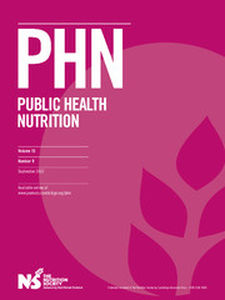Hot Topic – Nutrition for infants up to pre-school children
Editorial
Nutrition of infants and young children
-
- Published online by Cambridge University Press:
- 24 August 2012, pp. 1601-1602
-
- Article
-
- You have access
- HTML
- Export citation
Hot Topic – Nutrition for infants up to pre-school children Monitoring and surveillance
Research paper
Worldwide implementation of the WHO Child Growth Standards
-
- Published online by Cambridge University Press:
- 12 April 2012, pp. 1603-1610
-
- Article
-
- You have access
- HTML
- Export citation
Hot Topic – Nutrition for infants up to pre-school children Assessment and methodology
Research paper
Validation and extension of a simple questionnaire to assess physical activity in pre-school children
-
- Published online by Cambridge University Press:
- 01 June 2012, pp. 1611-1619
-
- Article
-
- You have access
- HTML
- Export citation
Comparison of a possession score and a poverty index in predicting anaemia and undernutrition in pre-school children and women of reproductive age in rural and urban Côte d'Ivoire
-
- Published online by Cambridge University Press:
- 12 June 2012, pp. 1620-1629
-
- Article
-
- You have access
- HTML
- Export citation
Development and test–retest reliability of a nutrition knowledge questionnaire for primary-school children
-
- Published online by Cambridge University Press:
- 13 June 2012, pp. 1630-1638
-
- Article
-
- You have access
- HTML
- Export citation
Hot Topic – Nutrition for infants up to pre-school children Epidemiology
Research paper
Relationship between breast-feeding and adiposity in infants and pre-school children
-
- Published online by Cambridge University Press:
- 28 February 2012, pp. 1639-1644
-
- Article
-
- You have access
- HTML
- Export citation
Temporal trends and anaemia-associated factors in 6- to 59-month-old children in Northeast Brazil
-
- Published online by Cambridge University Press:
- 14 March 2012, pp. 1645-1652
-
- Article
-
- You have access
- HTML
- Export citation
Differences in Danish children's diet quality on weekdays v. weekend days
-
- Published online by Cambridge University Press:
- 25 May 2012, pp. 1653-1660
-
- Article
-
- You have access
- HTML
- Export citation
Sources of weaning advice, comparisons between formal and informal advice, and associations with weaning timing in a survey of UK first-time mothers
-
- Published online by Cambridge University Press:
- 28 May 2012, pp. 1661-1669
-
- Article
-
- You have access
- HTML
- Export citation
Hot Topic – Nutrition for infants up to pre-school children Nutrition and health
Research paper
Intakes and adequacy of potentially important nutrients for cognitive development among 5-year-old children in the Seychelles Child Development and Nutrition Study
-
- Published online by Cambridge University Press:
- 10 February 2012, pp. 1670-1677
-
- Article
-
- You have access
- HTML
- Export citation
Parents’ misperceptions of social norms for pre-school children's snacking behaviour
-
- Published online by Cambridge University Press:
- 14 March 2012, pp. 1678-1682
-
- Article
-
- You have access
- HTML
- Export citation
Hb level in relation to vitamin D status in healthy infants and toddlers
-
- Published online by Cambridge University Press:
- 06 March 2012, pp. 1683-1687
-
- Article
-
- You have access
- HTML
- Export citation
Vitamin A intake and infection are associated with plasma retinol among pre-school children in rural Zambia
-
- Published online by Cambridge University Press:
- 23 March 2012, pp. 1688-1696
-
- Article
-
- You have access
- HTML
- Export citation
Infant and young child feeding practices and child undernutrition in Bangladesh: insights from nationally representative data
-
- Published online by Cambridge University Press:
- 08 May 2012, pp. 1697-1704
-
- Article
-
- You have access
- HTML
- Export citation
Infant feeding in relation to eating patterns in the second year of life and weight status in the fourth year
-
- Published online by Cambridge University Press:
- 25 May 2012, pp. 1705-1714
-
- Article
-
- You have access
- HTML
- Export citation
Trends and determinants of undernutrition among young Kenyan children: Kenya Demographic and Health Survey; 1993, 1998, 2003 and 2008–2009
-
- Published online by Cambridge University Press:
- 14 June 2012, pp. 1715-1727
-
- Article
-
- You have access
- HTML
- Export citation
Hot Topic – Nutrition for infants up to pre-school children Interventions
Research paper
Effect of high doses of folic acid supplementation in early pregnancy on child neurodevelopment at 18 months of age: the mother–child cohort ‘Rhea’ study in Crete, Greece
-
- Published online by Cambridge University Press:
- 08 February 2012, pp. 1728-1736
-
- Article
-
- You have access
- HTML
- Export citation
Effects of a 2-year healthy eating and physical activity intervention for 3–6-year-olds in communities of high and low socio-economic status: the POP (Prevention of Overweight among Pre-school and school children) project
-
- Published online by Cambridge University Press:
- 08 March 2012, pp. 1737-1745
-
- Article
-
- You have access
- HTML
- Export citation
An evaluation of an operations research project to reduce childhood stunting in a food-insecure area in Ethiopia
-
- Published online by Cambridge University Press:
- 17 April 2012, pp. 1746-1754
-
- Article
-
- You have access
- HTML
- Export citation
An effectiveness trial showed lipid-based nutrient supplementation but not corn–soya blend offered a modest benefit in weight gain among 6- to 18-month-old underweight children in rural Malawi
-
- Published online by Cambridge University Press:
- 13 June 2012, pp. 1755-1762
-
- Article
-
- You have access
- HTML
- Export citation

